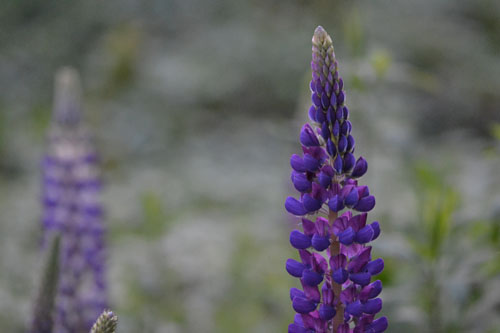This is my second attempt at growing lupines. I had these in the woodland garden last year, and they looked spectacular in early summer. Then it got warm and dry, and it stayed that way. The lupines withered and did not come back this year. I’m not sure if it was just the atypical heat though. The soil may have been a bit too rich. Lupines prefer a poorer quality sandy soil. Maybe the amount of shade was just a bit too much too. This time I put them out in a clearing and so far they look healthy – they are just now starting to push out their blue rockets of color. We’ll see how it goes. Lupinus polyphyllus is native to western North America, but it has escaped gardens on the east coast, and it has been introduced there as well. This lupine can also be found worldwide as an invasive or commercial import (which eventually becomes a human-aided hostile takeover imperiling some local native flora somewhere).
Even though I am a bit ambivalent about growing a small patch of lupines, they do offer benefits to many insects (bees and butterflies especially), and they are just a great flower to look at. Besides, it is still too early to tell if they will re-emerge next season.

| Scientific name: | Lupinus polyphyllus |
| Common name: | common lupine |
| Other name: | garden lupine, big-leaved lupine, large-leaved lupine |
| Bloom time: | mid spring to early summer |
| Color: | blue, blue-violet |
| Light requirements: | full sun to partial shade |
| Zone: | 4 to 7 |
| Soil: | acidic to neutral |
| Water: | moist |
| Origin: | western North America, naturalized on the east coast |
I enjoyed reading your post about lupines. I have always loved this flower and never imagined they could be considered a pest or invasive species to local flora. Is lupine a problem here on Cape Cod? I rarely see the plant growing anywhere but in a planned garden. It’s not like fields of it are growing anywhere such as was the case in the White Mts. of NH. (I thought those field beautiful btw, but now wonder if the plant in that setting was replacing important native vegetation.
I’ve been nursing some lupine seedlings for two years for my woodland garden (that has nice patches of sun). The plants are struggling. I see from your post that I’m being too kind. I do believe my soil contains too much clay to grow to maturity.
I’ll have to experiment. I appreciate the post.
Hi Tim
They are much more prevalent in NH, Vermont and upstate NY, you are right about that. I have seen them just off-cape on the route 3 exit toward Buzzards Bay. They seem to be thriving on the steep hill amongst the tall grass. The fact that that hill is not easy to mow may have something to do with it, but although they seem to be the native species I think they were seeded there by the highway department some time ago. There are many cultivars you could try to grow (they all attract bees), and you can find the natives at Garden in the Woods in Framingham – they have them available for purchase in the spring. I’ve found them finicky and on top of that the rabbits and woodchucks have pretty much done them in. You may need to fence them in or have them in a high (human or pet) traffic area to keep the herbivores away…